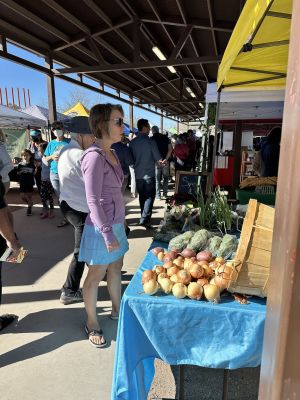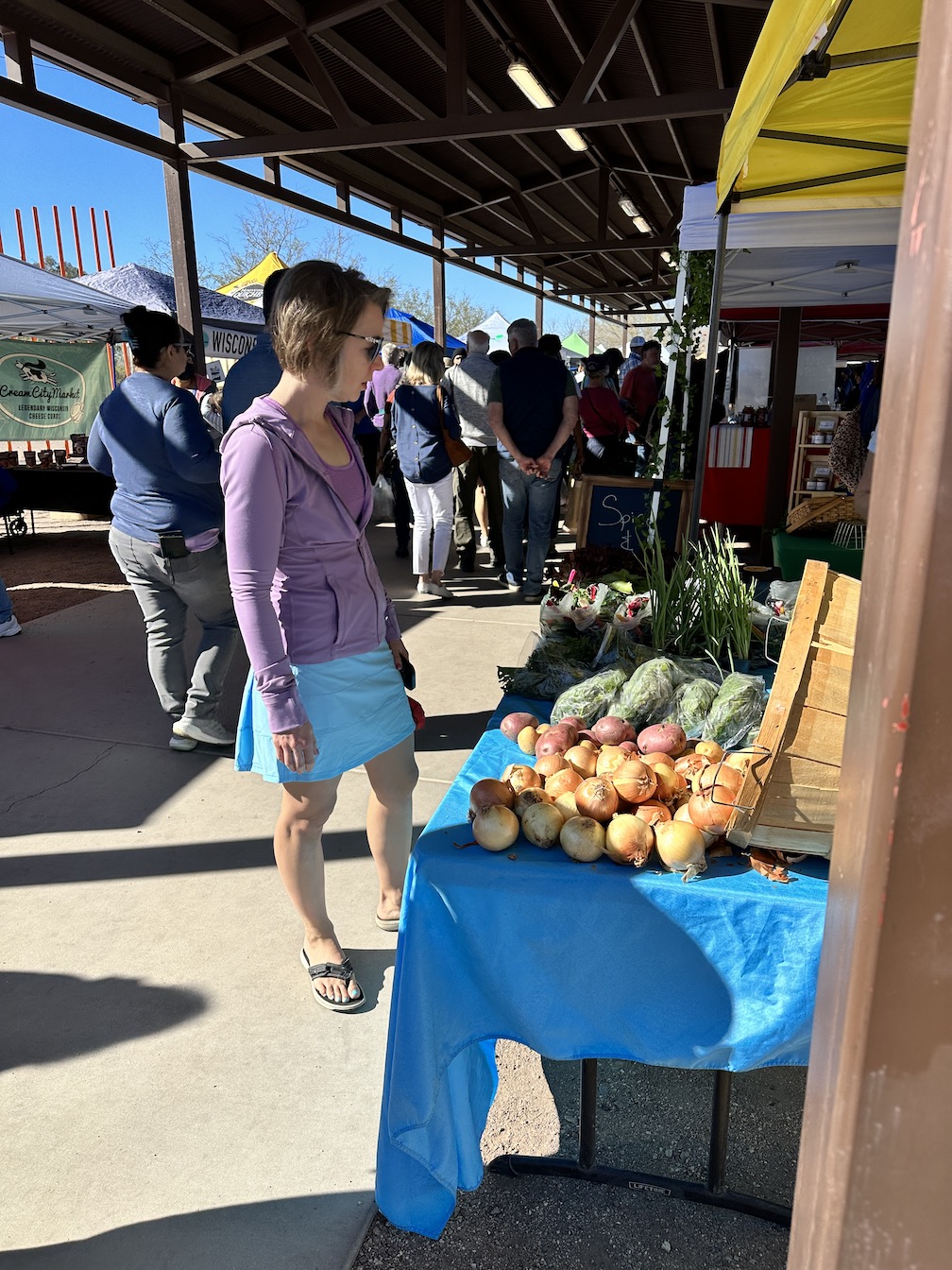For the Love of a Farmer's Market

For the Love of the Farmer’s Market
I love farmer’s markets! Really, I love them!! To the point that my husband doesn’t want to accompany me because I could spend all day meandering around the stalls of fresh fruits and vegetables – sniffing, squeezing, weighing and discussing each individual potentially delectable treat all day.
During a recent trip to Tucson, I apparently found the mecca of farmer’s markets. Tucson has, quite literally, a different market almost every day of the week. Over the course of the weekend, I went several days in a row and was not disappointed. Each day, there were some of the same stands but always several new ones with different things to try.
For those who have never been to a real farmer’s market, let me give you the lay of the land. The original intent of the market was to put the producer (farmer, baker, fisher, etc.) in direct contact with the consumer (usually me) so that both the price and the quality for fresh produce and goods is better than in the supermarket. The producers make more off their products and the customer gets the freshest possible options. The most common products are fruits and vegetables, jams, honey, jerky, bread or baked goods, meat, cheese and dairy, eggs, and sometimes fish. At most farmer’s markets, there are also many vendors selling handcrafted goods such as pottery, paintings, photographs, carvings, etc. Previously, farmer’s markets were the way to grab produce at the cheapest cost while still paying the farmer a fair wage. However, more recently farmer’s markets have been so popular that some farmers will charge top dollar – even more than they charge normally.
My experience in Tucson was among the best I’ve ever had. The prices for organically grown vegetables were INCREDIBLY low, including $2/pound of organic brussels sprouts and carrots. Local honey was $8/pound. There were tons of leafy green options such as lettuces, kale, chard, and sprouts that were all very reasonable. When it came to dairy, meat and seafood, the prices were a bit higher, but all comparable to any local grocery store. There were also SO many new things to try – limequats, Mizuna, and pomelos were just some of the things I found along with some random citrus hybrids (tangerines crossed with an orange was a delicious one). Each farm had their own assortment of heirloom vegetables as well based on the individual farmer’s preferences and what sells well.
This brings up one of the best parts of a farmer’s market – the ability to support a local farmer. Farmers work exceptionally hard and are the backbone of our country, growing the food that feeds millions of people, cattle, poultry, etc. each year. Unfortunately, economic pressures are driving many farmers out of business and/or to monoculture crops that rely heavily on pesticide use. Smaller, biodiverse, sustainably, and organically grown farms are finding it harder to harder to stay in business, hence the higher prices at the farmer’s market. Choosing to support local growers is a huge step each of us can take toward keeping our local farmers in business and practicing responsible growing practices.
At the Tucson markets, you can look for the “Get Real” certification flags at the vendor’s booths to tell you who is local and who isn’t. Unfortunately, there have been some well publicized cases in both the USA and Canada of people presenting their store-bought produce as home grown at farmer’s markets to make more money rather than doing the hard labor of growing it on their own. CBC Canada did an expose on this a few years ago (https://www.cbc.ca/news/business/farmers-markets-lies-marketplace-1.4306231) and other news agencies like NPR and the LA Times have reported on it as well. (https://www.npr.org/sections/thesalt/2014/10/02/352979875/california-cracks-down-on-farmers-market-cheaters)
https://www.latimes.com/food/dailydish/la-dd-here-are-five-tipoffs-that-can-help-you-avoid-farmers-market-cheaters-20131227-story.html
However, back in Montana, it’s a bit easier to figure out who the local growers are. A quick google search and a short (<2 hour) drive will get you to the farm if you were so inclined. The Yellowstone Valley Food Hub has made it even easier though. If you haven’t heard of them, they are a grower’s cooperative serving central and eastern Montana with over 35 producers from across Montana and Wyoming. I have no financial interest in this group, except that I purchase fresh produce and dairy from them all year long (with summer being by far the best time to buy!). I love being able to support local farmers and get the freshest, top-quality products that Montana has to offer. During the summer, it’s essentially like going to the farmer’s market except that I go online to order and pick up my bag of groceries on Thursday evening on my way home from work. I usually place my order on the weekend, that way I can plan my meals for the week. You can also adjust your order up until 2 days prior. Finally, I like being able to research each farm/producer ahead of time to know their location, organic vs. sustainable vs. conventional, etc. If you have a question, you can even send them an email and you’ll generally get a response in a few days. If you haven’t already, I highly recommend you check them out: https://www.yvfoodhub.com/. You also have the option of going to the farmer’s market in the summer to pick your own produce. The Yellowstone Valley Farmer’s Market (http://www.yvfm.org/) is open on the weekends downtown from July through October and the Gardners’ Market (https://www.healthybydesignyellowstone.org/what-we-do/current-initiatives/gardeners-market/) is open Thursday evenings June through October in South Park. Look for the “Made in Montana” or “Grown in Montana” stickers to ensure your products are local through the MT Department of Commerce program (https://www.madeinmontanausa.com/).
So why the long discussion on farmer’s markets? Because a large part of being healthy means making daily food choices that feed our bodies the best quality food we can afford. Fresh fruits and vegetables picked the same day or the day before are going to be a much better source of vitamins and minerals than those in the grocery store that were picked unripe and packed on trucks and transported hundreds of miles to sit on grocery store shelves for several days. Buying local also means the possibility of more heirloom and organic vegetables rather than conventionally grown or genetically modified produce that were engineered for shelf life rather than flavor. Better flavor means we’re more likely to eat more of the good stuff – vitamins, minerals, water and fiber! The same goes for meat, dairy, eggs, honey and other products. Did you know that pasture raised chickens produced eggs with over twice as much Vitamin E and omega 3 fatty acids than caged chicken produced eggs? Pasture raised chicken eggs also have a significantly improved ratio of omega 3 (good) to omega 6 (bad) fatty acids. Plus, amid “Eggflation” I’ve found the prices to be the same, if not better, than the grocery store lately. Eating local is better for our bodies, our farmers, and our purses so before you head to the grocery store, explore some options and consider purchasing a part or all of your groceries through local channels.
